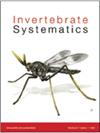丢失的特征和丢失的分类学家:科。nov.,Poecilosclerida,有和没有螯,以适应假定的根皮目(Haplosclerida)
IF 1.9
2区 生物学
Q3 EVOLUTIONARY BIOLOGY
引用次数: 0
摘要
摘要:对大亚马逊珊瑚礁系统海绵进行了分类研究,发现了3种大体形态相似的类海洋海绵(Phloeodictyidae, Haplosclerida),其中2种初步鉴定为O. barschi,另1种初步鉴定为Coelocarteria (Poecilosclerida),因为存在共同的掌部等螯。所有三个物种在大体形态上的显著总体相似性需要对系统发育亲缘性进行综合评估。从Genbank中收集了单倍核和单倍核序列(18S和28S rRNA),并与亚马逊河口2个类大海鱼种元基因组的参考序列进行了比较,其中1个与O. barschi匹配。两个巴西种与新加坡腔动脉(新加坡)聚集在一起。这些物种在Poecilosclerida中筑巢,远离Oceanapia (sp.和isodictyiformis)和其他单纲动物(Amphimedon, Petrosia, Siphonodictyon和Xestospongia),但也远离poecilosclerid Isodictya,后者目前与coelocartia属于同一科,属于isodictyae。有螯的标本被命名为Coelocarteria alcoladoi sp. 11 .,而没有螯的标本则代表另外两种。其中一个匹配的是巴氏红血球(O. bartschi的全型,此处重新检查),从而支持该物种向腔动脉的转移。另一种被认为是C. amadoi sp. 11 .,是该属中第二个已知的脂切属物种。28S系统发育恢复了巴氏腔动脉梳。11 .(原Oceanapia bartschi)在与腔冠虫属聚集的Poecilosclerida分支中,包括该属的模式种,C. singaporensis, 100%支持。同样不带螯的Coelocarteria alcoladoi sp. nov.,归为同一分支,从而证实了该属的分类。Coelocarteria sp.与corulella sp.组成的分支表明这两个属之间有亲缘关系。腔脉虫目前属于异卵虫科,角藻属蜘蛛科。异蚊科异蚊属(isodictyae)与无翅虫属(Amphilectus, Esperiopsidae)同属,具有较高的支撑力,与腔脉虫仅有远亲关系。刺螨(刺螨科)与刺螨属同组,也有较高的支撑力,远离腔动脉属和矢车菊属。这些结果表明异卵虫科和棘虫科具有多系性,因此我们倾向于提出一个新的、目前单一的腔动脉科,即腔动脉科。11 . ZooBank: urn:lsid:zoobank.org:pub:71FDB6FD-4A5F-4180-8DA7-79EA4CB615D1本文章由计算机程序翻译,如有差异,请以英文原文为准。
Lost characters and lost taxonomists: Coelocarteriidae fam. nov., Poecilosclerida with and without chelae, to accommodate supposed phloeodictyids (Haplosclerida)
ABSTRACT The taxonomic study of Great Amazon Reef System sponges yielded three Oceanapia-like (Phloeodictyidae, Haplosclerida) species of similar gross morphology, two preliminarily identified as O. bartschi and another as Coelocarteria (Poecilosclerida), due to the presence of common palmate isochelae. The remarkable overall similarity of all three species in gross morphology necessitated an integrative assessment of the phylogenetic affinities. A selection of haplosclerid and poecilosclerid sequences (18S and 28S rRNA) was gathered from Genbank and compared to sequences mapped to reference from metagenome of two Oceanapia-like species from the Amazon River mouth, one of which matched O. bartschi. Both Brazilian species clustered with Coelocarteria singaporensis (Singapore). These species nest in the Poecilosclerida, far from Oceanapia (sp. and isodictyiformis) and other haplosclerids (Amphimedon, Petrosia, Siphonodictyon and Xestospongia) but also far from the poecilosclerid Isodictya that is currently classified in the same family as Coelocarteria, the Isodictyidae. Specimens with chelae are named Coelocarteria alcoladoi sp. nov. herein, while those without chelae represent the other two species. One matched Inflatella bartschi (O. bartchi’s holotype, here re-examined), thereby supporting the transfer of this species to Coelocarteria. The other is proposed as C. amadoi sp. nov. and is the second known lipochelous species in this genus. The 28S phylogenies recovered Coelocarteria bartschi comb. nov. (formerly Oceanapia bartschi) in the Poecilosclerida clade that clustered with Coelocarteria spp., including the type species of this genus, C. singaporensis, with 100% support. Coelocarteria alcoladoi sp. nov., also without chelae, grouped in the same clade, thereby corroborating the classification in this genus. The clade composed of Coelocarteria spp. grouped with Cornulella sp., suggesting an affinity between these genera. Coelocarteria is currently situated within Isodictyidae and Cornulella in Acarnidae. Isodictya (Isodictyidae) grouped with Amphilectus (Esperiopsidae) with high support and is only distantly related to Coelocarteria. Acarnus (Acarnidae) grouped with Clathria, also with high support, far from Coelocarteria and Cornulella. These results suggest the polyphyletic nature of Isodictyidae and Acarnidae, for which reason we preferred to propose a new, currently monotypic family for Coelocarteria spp., Coelocarteriidae fam. nov. ZooBank: urn:lsid:zoobank.org:pub:71FDB6FD-4A5F-4180-8DA7-79EA4CB615D1
求助全文
通过发布文献求助,成功后即可免费获取论文全文。
去求助
来源期刊

Invertebrate Systematics
生物-动物学
CiteScore
4.30
自引率
9.10%
发文量
35
审稿时长
>12 weeks
期刊介绍:
Invertebrate Systematics (formerly known as Invertebrate Taxonomy) is an international journal publishing original and significant contributions on the systematics, phylogeny and biogeography of all invertebrate taxa. Articles in the journal provide comprehensive treatments of clearly defined taxonomic groups, often emphasising their biodiversity patterns and/or biological aspects. The journal also includes contributions on the systematics of selected species that are of particular conservation, economic, medical or veterinary importance.
Invertebrate Systematics is a vital resource globally for scientists, students, conservation biologists, environmental consultants and government policy advisors who are interested in terrestrial, freshwater and marine systems.
Invertebrate Systematics is published with the endorsement of the Commonwealth Scientific and Industrial Research Organisation (CSIRO) and the Australian Academy of Science.
 求助内容:
求助内容: 应助结果提醒方式:
应助结果提醒方式:


